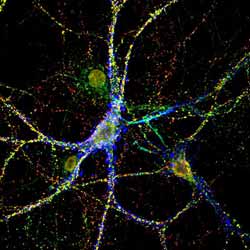Commands from the matrix: cellular environment controls neuronal connections

Neuron in the net: The illustration shows a neuron from the hippocampus of a mouse in cell culture, which is surrounded by a special structure of the extracellular matrix - a perineuronal net (blue). Various structures of the synapse are coloured red, green and yellow.<br>Image: RUB, Department of Cell Morphology and Molecular Neurobiology<br>
Environment moulds behaviour – and not just that of people in society, but also at the microscopic level. This is because, for their function, neurons are dependent on the cell environment, the so-termed extracellular matrix. Researchers at the Ruhr-Universität have found evidence that this complex network of molecules controls the formation and activity of the neuronal connections.
The team led by Dr. Maren Geißler und Prof. Andreas Faissner from the Department of Cell Morphology and Molecular Neurobiology reports in the “Journal of Neuroscience” in collaboration with the team of Dr. Ainhara Aguado, Prof. Christian Wetzel and Prof. Hanns Hatt from the Department of Cell Physiology.
Neurons and astrocytes in culture
In cooperation with Prof. Uwe Rauch from Lund University in Sweden, Bochum’s biologists examined cells from the brains of two mouse species: a species with a normal extracellular matrix and a species which lacked four components of the extracellular matrix due to genetic manipulation, namely the molecules tenascin-C, tenascin-R, neurocan and brevican. They took the cells from the hippocampus, a brain structure that is crucial for the long-term memory. The team not only examined neurons but also astrocytes, which are in close contact with the neurons, support their function and secrete molecules for the extracellular matrix.
Formation, stability and activity of the neuronal connections depend on the matrix
The researchers cultivated the neurons and astrocytes together for four weeks with a specially developed culture strategy. Among other things, they observed how many connections, known as synapses, the neurons formed with each other and how stable these were over time. If either the astrocytes or the neurons in the culture dish derived from animals with a reduced extracellular matrix, these synapses proved to be less stable in the medium term, and their number was significantly reduced.
Together with the Department of Cell Physiology at the RUB and the University of Regensburg, the team also showed that the neurons with a mutated matrix showed lower spontaneous activity than normal cells. The extracellular matrix thus regulates the formation, stability and activity of the neuronal connections. The researchers also examined a special structure of the extracellular matrix, the so-called perineuronal nets, which the Nobel laureate Camillo Golgi first described more than a century ago. They were significantly reduced in the environment of genetically modified cells.
Bibliographic record
M. Geissler, C. Gottschling, A. Aguado, U. Rauch, C.H. Wetzel, H. Hatt, A. Faissner (2013): Primary hippocampal neurons, which lack four crucial extracellular matrix molecules, display abnormalities of synaptic structure and function and severe deficits in perineuronal net formation, Journal of Neuroscience, DOI: 10.1523/JNEUROSCI.3275-12.2013
Further information
Prof. Dr. Andreas Faissner, Department of Cell Morphology and Molecular Neurobiology, Faculty of Biology and Biotechnology at the Ruhr-Universität, 44780 Bochum, Germany, Tel. +49/234/32-28851, E-mail: Andreas.Faissner@rub.de
Editor: Dr. Julia Weiler
Media Contact
More Information:
http://www.ruhr-uni-bochum.deAll latest news from the category: Life Sciences and Chemistry
Articles and reports from the Life Sciences and chemistry area deal with applied and basic research into modern biology, chemistry and human medicine.
Valuable information can be found on a range of life sciences fields including bacteriology, biochemistry, bionics, bioinformatics, biophysics, biotechnology, genetics, geobotany, human biology, marine biology, microbiology, molecular biology, cellular biology, zoology, bioinorganic chemistry, microchemistry and environmental chemistry.
Newest articles

Combatting disruptive ‘noise’ in quantum communication
In a significant milestone for quantum communication technology, an experiment has demonstrated how networks can be leveraged to combat disruptive ‘noise’ in quantum communications. The international effort led by researchers…

Stretchable quantum dot display
Intrinsically stretchable quantum dot-based light-emitting diodes achieved record-breaking performance. A team of South Korean scientists led by Professor KIM Dae-Hyeong of the Center for Nanoparticle Research within the Institute for…

Internet can achieve quantum speed with light saved as sound
Researchers at the University of Copenhagen’s Niels Bohr Institute have developed a new way to create quantum memory: A small drum can store data sent with light in its sonic…





















